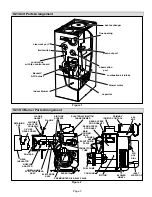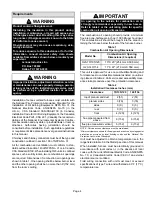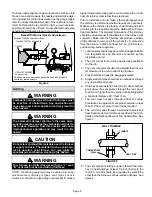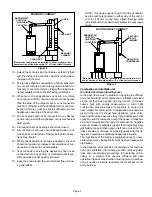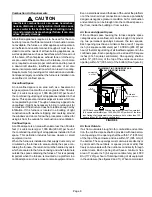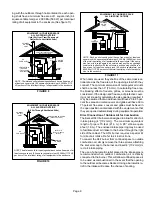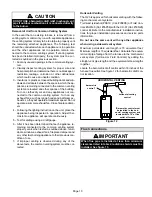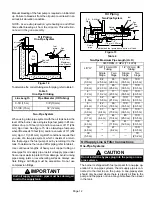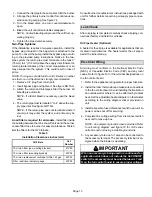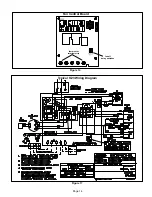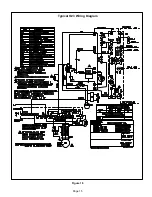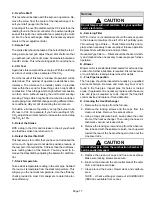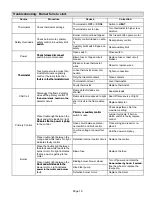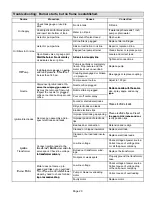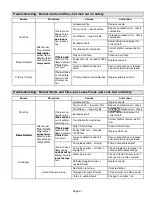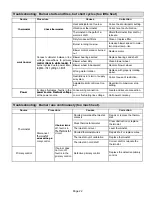
Page 7
MASONRY CHIMNEY
BAROMETRIC
CONTROL*
(IN EITHER
LOCATION)
CLEAN OUT
CLEAN OUT
LINER
MASONRY
CHIMNEY
Figure 6
*Barometric control may be installed in either vertical or hori-
zontal section of flue pipe within 18" of flue outlet of furnace.
10− Extend the vent pipe into the chimney so that it is flush
with the inside of the vent liner. Seal the joint between
the pipe and the liner.
11− The furnace shall be connected to a factory built chim-
ney or vent complying with a recognized standard, or
masonry or concrete chimney lined with a lining mate-
rial acceptable to the authority having jurisdiction.
12− When two or more appliances vent into a common
vent, the area of the common vent should not be less
than the area of the largest vent or vent connection
plus 50% of the area of the additional vent or vent con-
nection. Chimney must be able to sufficiently vent all
appliances operating at the same time.
13− The vent pipe shall not be connected to a chimney
vent serving a solid fuel appliance or any mechanical
draft system.
14− All unused chimney openings should be closed.
15− All vent pipe run through unconditioned areas or out-
side shall be constructed of factory built chimney sec-
tions. See figure 7.
16− Where condensation of vent gas is apparent, the vent
should be repaired or replaced. Accumulation of con-
densation in the vent is unacceptable.
17− Vent connectors serving this appliance shall not be
connected into any portion of mechanical draft sys-
tems operating under positive pressure.
18− Keep the area around the vent terminal free of snow,
ice and debris.
NOTE − If vent pipe needs to exit from side of cabinet,
use the pilot hole (located on either side of the unit) to
cut a 6" (152 mm) round hole. Attach finishing plate
(provided) with four sheet metal screws to cover rough
edges.
FACTORY−BUILT CHIMNEY
BAROMETRIC
CONTROL*
(IN EITHER
LOCATION)
DRAIN FOR
CONDENSATE
FACTORY
BUILT
CHIMNEY
Figure 7
*Barometric control may be installed in either vertical or hori-
zontal section of flue pipe within 18" of flue outlet of furnace.
Combustion and Ventilation Air
(Confined and Unconfined Spaces)
In the past, there was no problem in bringing in sufficient
amounts of outdoor air for combustion − infiltration provided
all the air that was needed and then some. In today’s
homes built with energy conservation in mind, tight
construction practices make it necessary to bring in air
from outside for combustion. Consideration must also be
given to the use of exhaust fans, appliance vents, chim-
neys and fireplaces because they force additional air that
could be used for combustion out of the house. Unless out-
side air is brought into the home for combustion, negative
pressure (pressure outside is greater than inside pressure)
will build to the point that a down draft can occur in the fur-
nace vent pipe or chimney. Combustion gases enter the liv-
ing space creating a potentially dangerous situation.
The importance of the previous paragraph cannot be over-
stated. Users may inadvertently block fresh air intakes after
installation.
In the absence of local codes concerning air for combus-
tion and ventilation, the following section outlines guide-
lines and recommends procedures for operating oil fur-
naces in a manner that ensures efficient and safe
operation. Special consideration must be given to combus-
tion air needs as well as requirements for exhaust vents
and oil piping.



